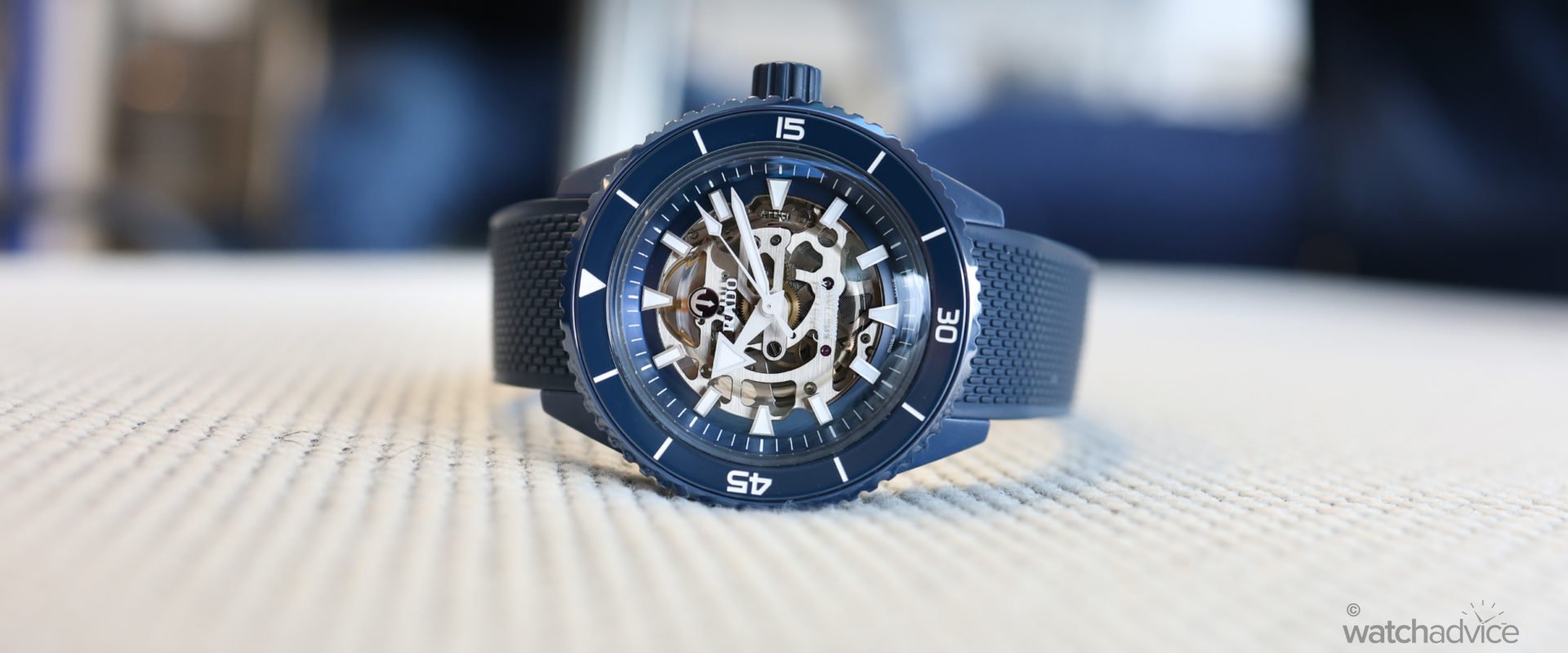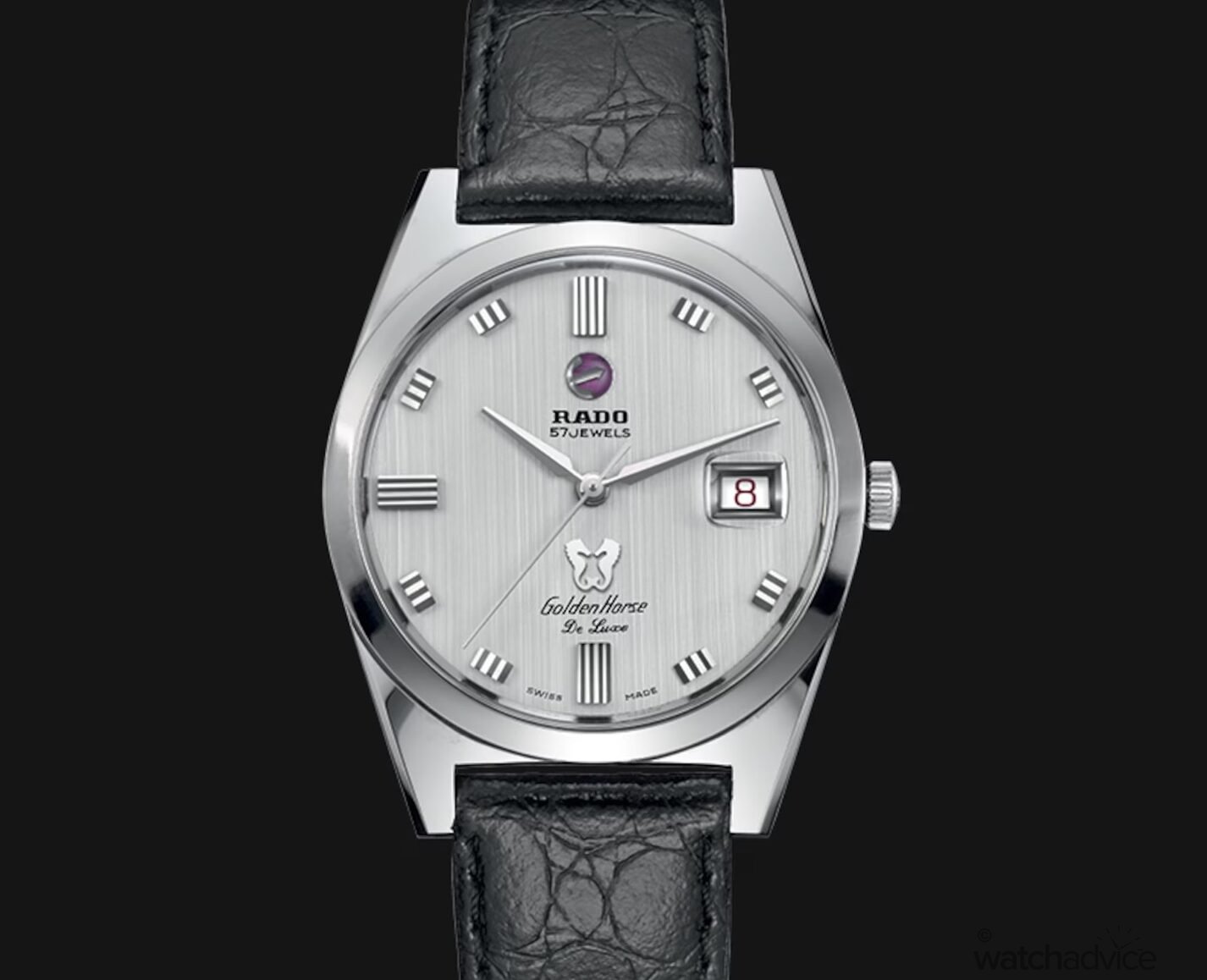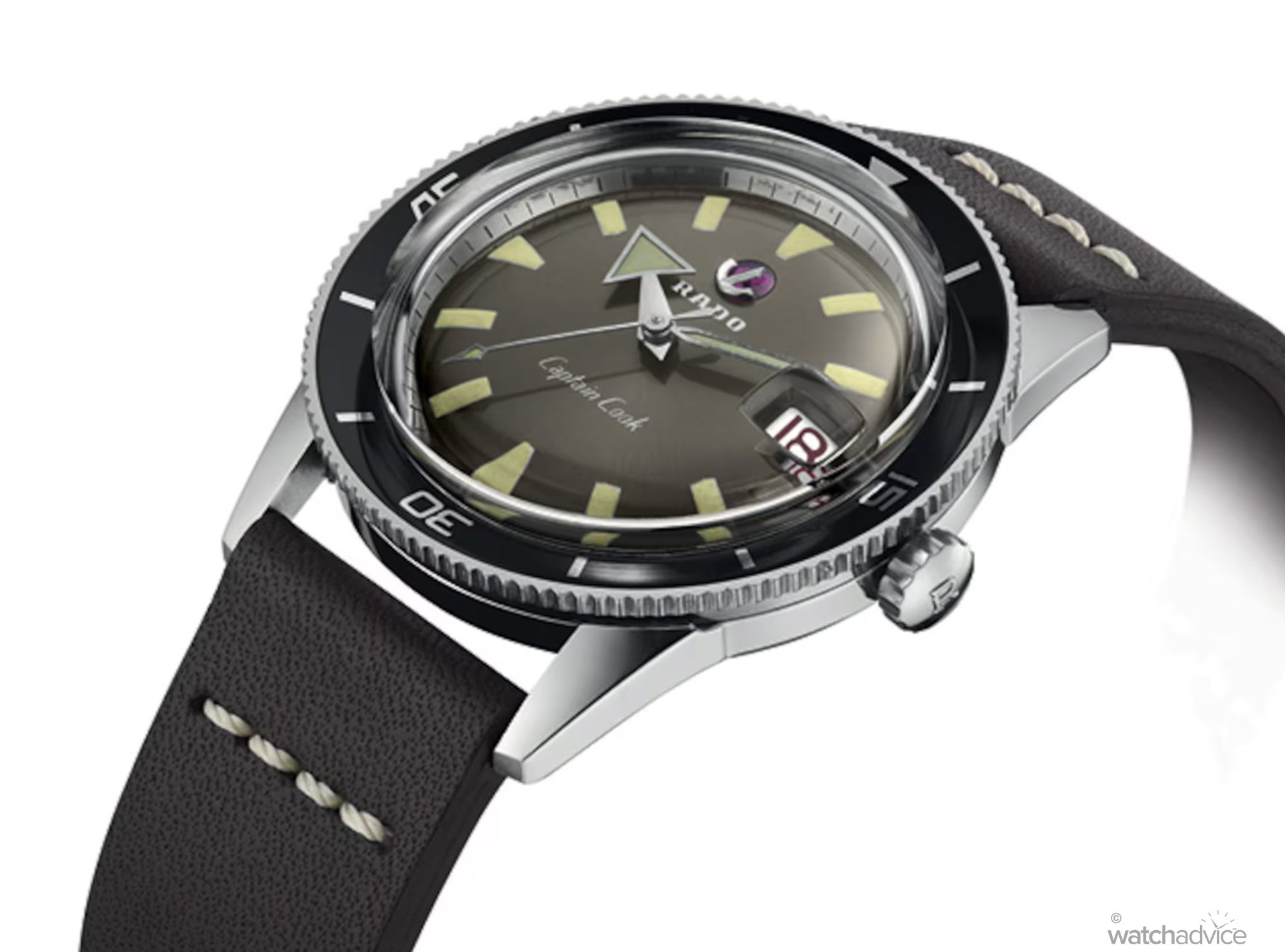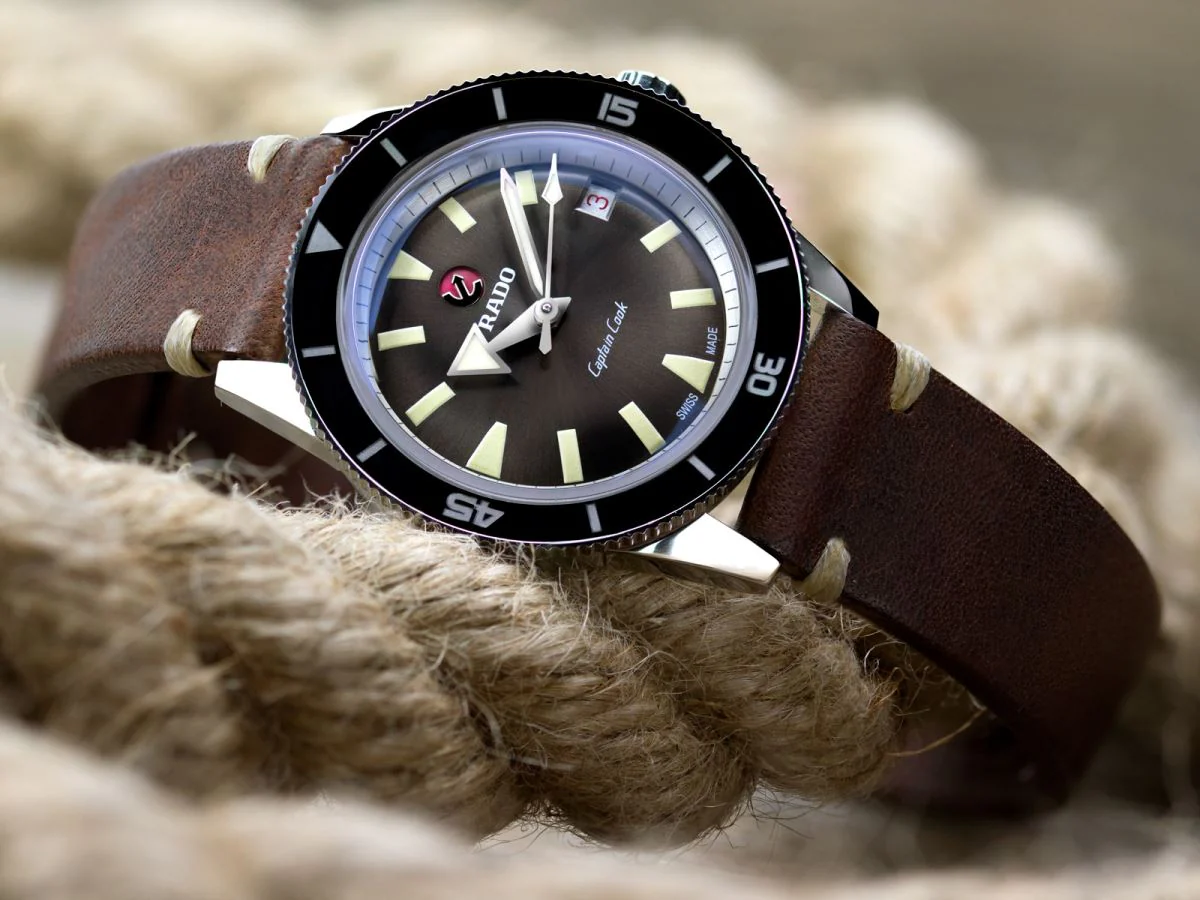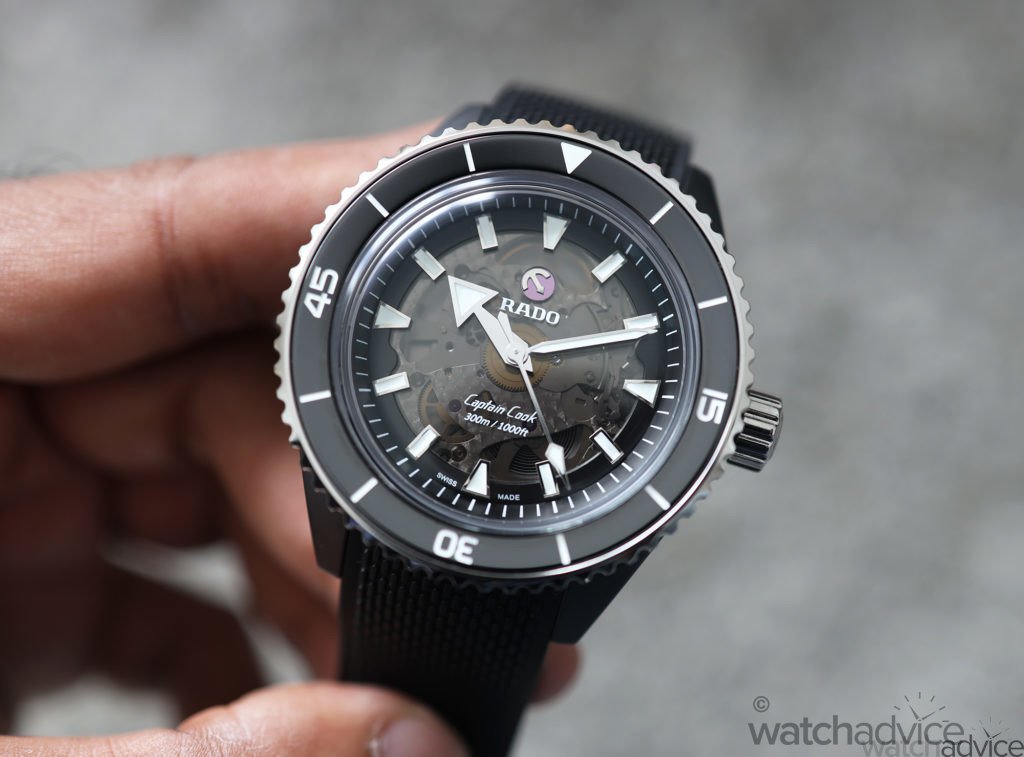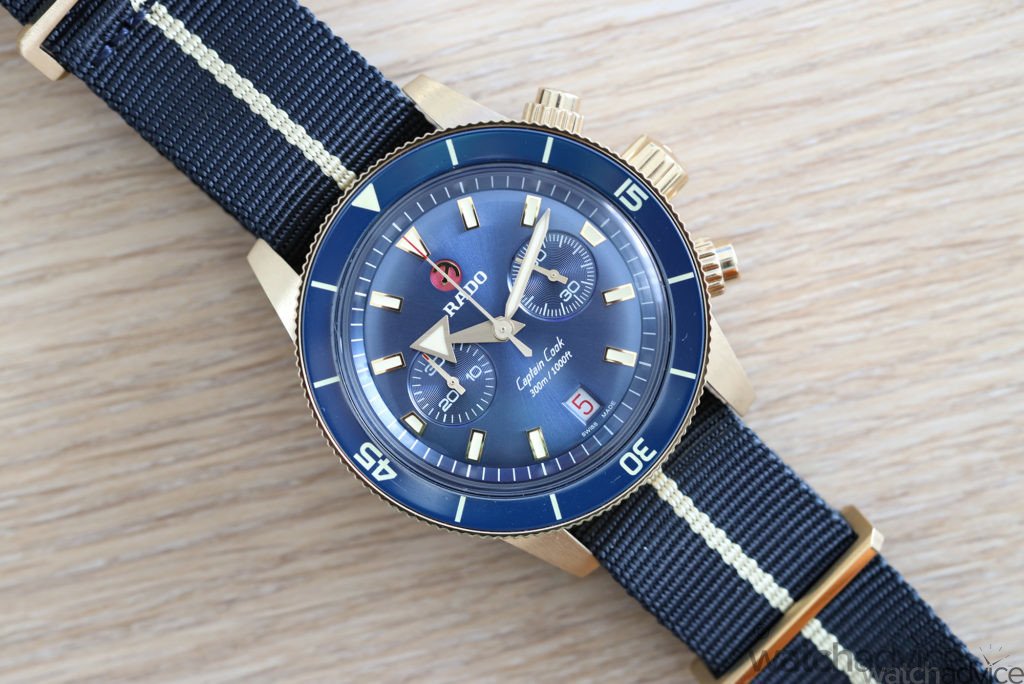IN PARTNERSHIP: With Father’s Day approaching, we’ve partnered with Rado to take a look into the evolution of the Captain Cook and the materials to create this adventurer’s watch, and maybe something for Dad on his special day!
The Rado Captain Cook. It’s an apt name for the watch that was originally designed in 1962 and developed by Rado for “doctors, engineers, athletes, deep sea divers, racing car drivers… ” as the original marketing campaign stated. People who were at the forefront of their field, pioneers and leaders in their own right, the monika of Captain Cook seems fitting. If Captain James Cook was around today, I’m sure he’d be on Rado’s ambassador list being the intrepid explorer he was.
The 1960’s was a great era for watches, and dive watches in particular as it was when the industry was really doubling down on these stainless steel sports watches. Many icons that we know and love today were born out of this era, and keen to capitalise on the trends of the day, brands like Rado, introduced a highly robust, water-resistant steel dive watch that could go anywhere and do anything – the original GADA timepiece.
A Brief History Of Rado
Before we get into the Captain Cook and the materials Rado uses, we should take a step back in time to where it all began for Rado – 1917. Rado like many Swiss watch brands had humble beginnings and starting with a family. In this case, it was three brothers: Fritz, Ernst, and Werner Schlup who set up their own watchmaking workshop in part of their parent’s home in the village of Lengnau, Switzerland, which is about 2hrs drive North East of Geneva, or 40 minutes drive North of Bern. This is where you’ll find Rado still today.
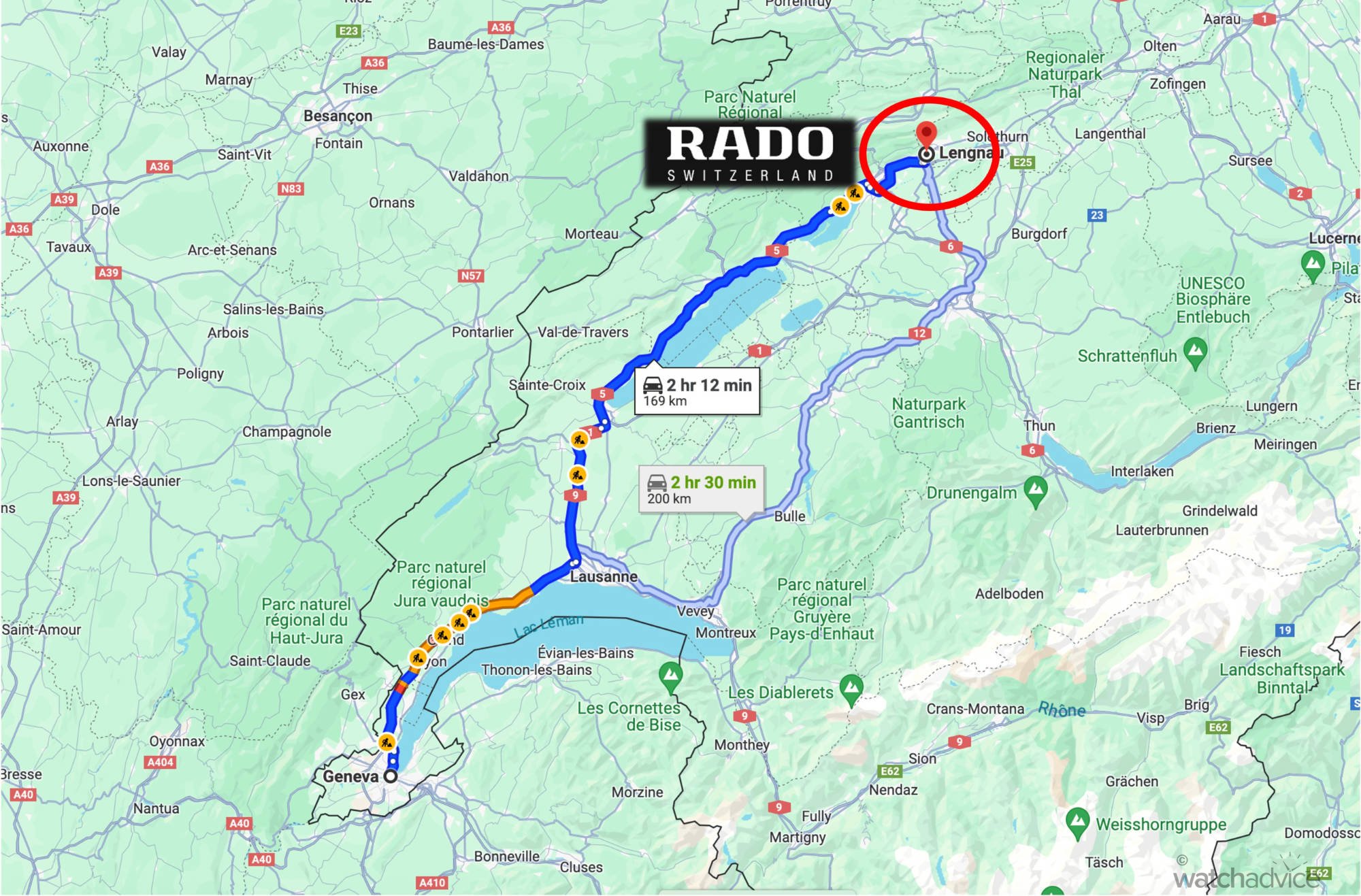
Just over a decade later, the brothers create the brand, Rado in 1928. Rado means “wheel” in Esperanto, and takes inspiration from the gear wheels inside the mechanical watches. At this time, the business was still called Schlup & Co, and the brothers exported their watches to various places around the globe, but mostly the United States under a white-label product, or sometimes known as Rado. This continued until 1956 when the brand Rado was now being used on all its watches and then a year later, the “Golden Horse” piece came to market, signifying a new era for the Rado brand.
With watch sales going well, and new countries being explored, Rado focused on their motto, “If we can imagine it, we can make it. And if we can make it, we will”. This philosophy saw Rado starting to experiment with materials for their cases as well as technical advancements in their watches. This is where the pivoting Rado anchor on the watch was born – a patented mechanism to let people know their watch needed servicing if it stopped rotating. The second patent was for a sealed case to ensure the water resistance of Rado watches. Then in 1962, the Rado Captain Cook was born.
Rado’s First Dive Watch
Capitalising on the steel sports watch trend that began in the 1960s, Rado introduced the Captain Cook. A 220m water-resistant dive watch in steel, and the first to have its patented waterproof sealed case, not to mention the pivoting anchor jewel on the dial. It was a good-looking watch in a 37mm sizing that quickly became a best seller for the brand.
However, the Captain Cook would only be in production for a short period and was discontinued in 1968 with reportedly 8,000 units sold (a decent amount for a watch brand at the time!) Nonetheless, the design endured and due to the way Rado designed the case and dial, doesn’t look out of place today – partly thanks to the styling and partly thanks to vintage and retro design cues having a resurgence of late.
Back To The Future
As the saying goes, what’s old is new again. This is a saying that is no truer than in the watch world where vintage designs and models from decades past make a resurgence and get a second chance at life. So almost 50 years after the last Captain Cook left the Manufacture in Lengnau, the Rado Captain Cook was brought back to life at Basel World in 2017 as a modern reinterpretation of the 1962 diver. All the design cues were there, even the 37mm sizing.
Based on feedback, Rado seemed to have had a new hit on their hands, and from here it was only a matter of time before the brand would introduce several new models and sizes to the Captain Cook range. 37mm was true to the original, but on the smaller side for the tastes in 2017. So in 2019, Rado showcased the 42mm version of the watch, now water resistant to a modern 300m depth rating to compete with other dive watches. We reviewed this piece back in 2020, which you can read in-depth here.
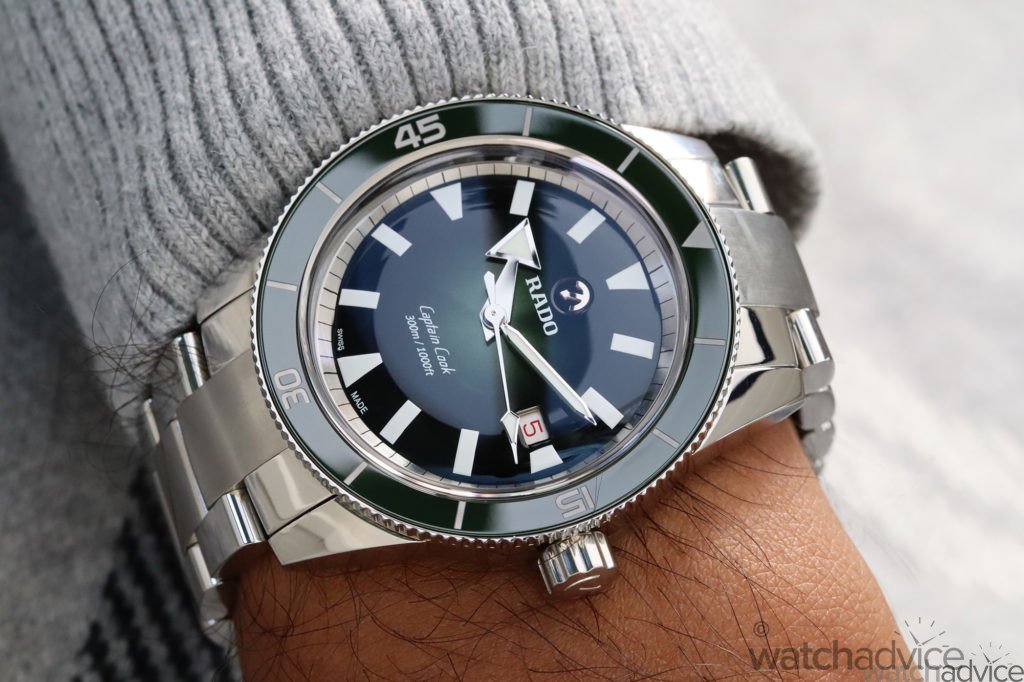
Diving Into The Material World
Rado’s foray into scratch-proof materials dates all the way back to the ’60s – 1962 in fact when Rado released the DiaStar in a substance they named Hardmetal. Essentially blending Tungsten Carbide Ceramic with a metal binder to create a material that looked like steel, but with the lightness and toughness, not to mention the scratch resistance of ceramic. This creation eventually led Rado to develop what we know today as High-Tech Ceramic. This was first released in 1986 with the Rado Integral.
Rado’s first High-Tech Ceramic Captain Cook came in 2021 with the launch of the 43mm Captain Cook High-Tech Ceramic. Taking the traditional design cues from the vintage and previous models, Rado incorporated this with their mastery of Ceramic – in this case, their High-Tech Ceramic.
RELATED READING: 2021 Rado Captain Cook High-Tech Ceramic Hands On Review
Ceramic is a great material when it comes to watchmaking. Whilst it’s incredibly hard to perfect, especially with colour, it allows the watch to always look new and retain its finish years, even decades after it has been made. Not satisfied with High-Tech Ceramic, Rado who are continually innovating, launched High-Tech Plasma Ceramic not long after this, and in 2022, The Captain Cook was given this treatment. It’s a unique-looking material that Rado achieves by process enriches completely finishing white high-tech ceramic elements with carbon, giving them a metallic finish. These surfaces can then be brushed, or polished to attain the required look. When you see it in person looks like they’ve infused the ceramic with metal.
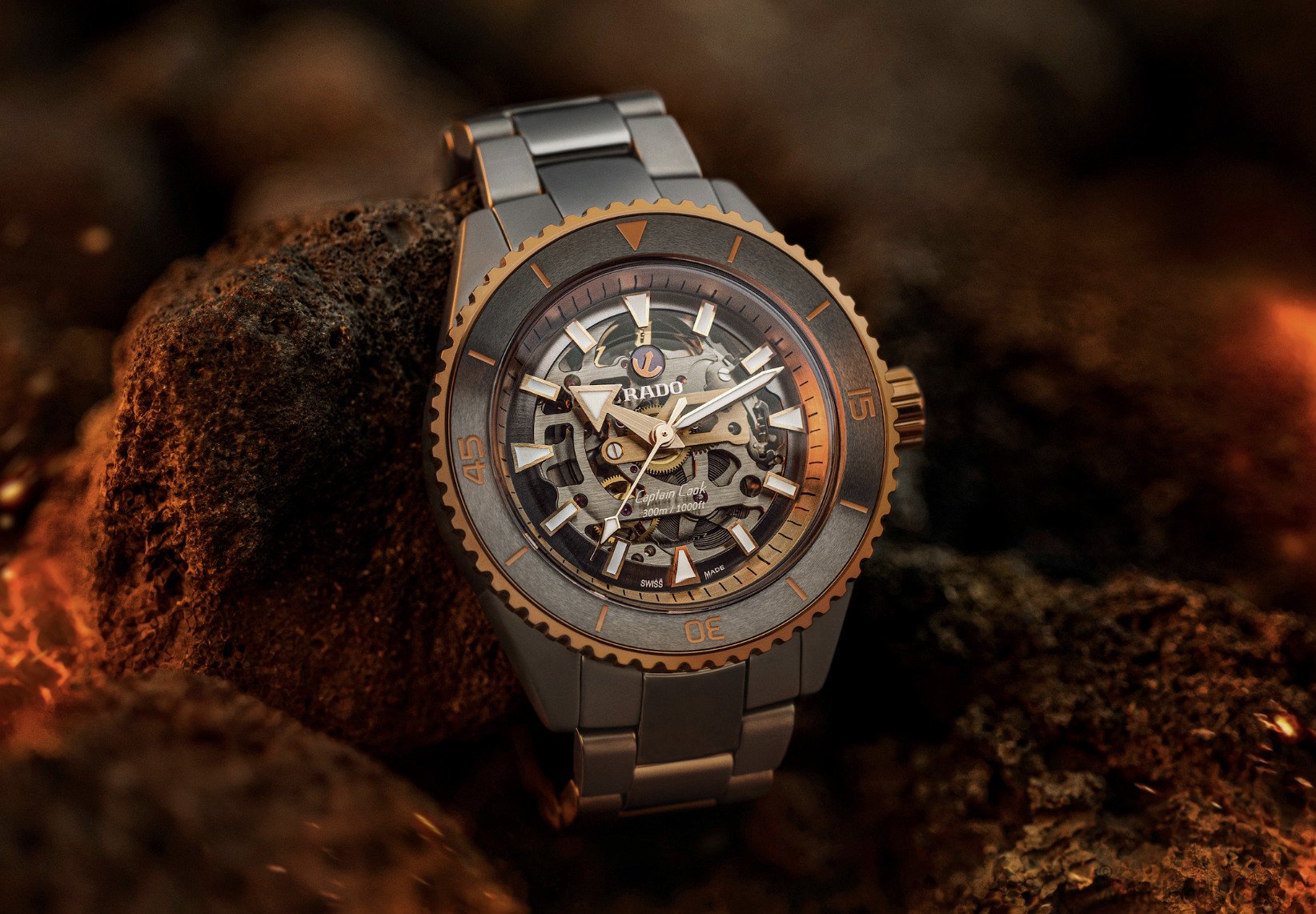
Now ceramic wouldn’t be as fun without some colour, but coloured ceramic is notoriously hard to make at scale, which is why only a few brands in the world do it, and do it well. As a rough idea, brighter colours need a greater level of care, and when being produced, the base material needs to be infused with the pigment and sintered at lower temperatures than conventional darker colours. In ceramic production, it’s a combination of time, temperature and pressure.
One of these such pieces is the Blue Rado Captain Cook Hight-Tech Ceramic released earlier this year. Mixed with the white indices and bezel markers, it’s fresh and looks great on the wrist, and probably one of the nicest-looking pieces in the Captain Cook Collection.
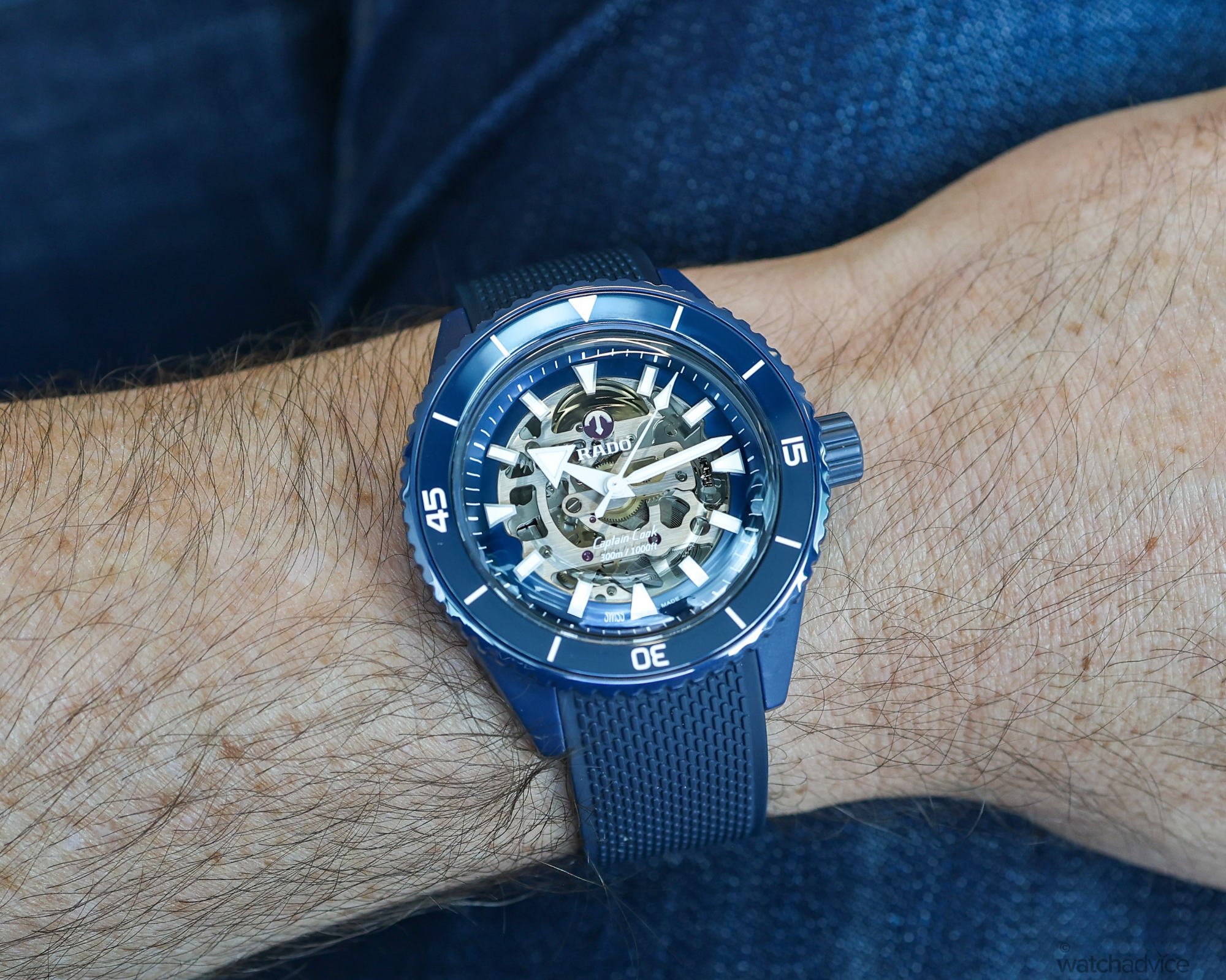
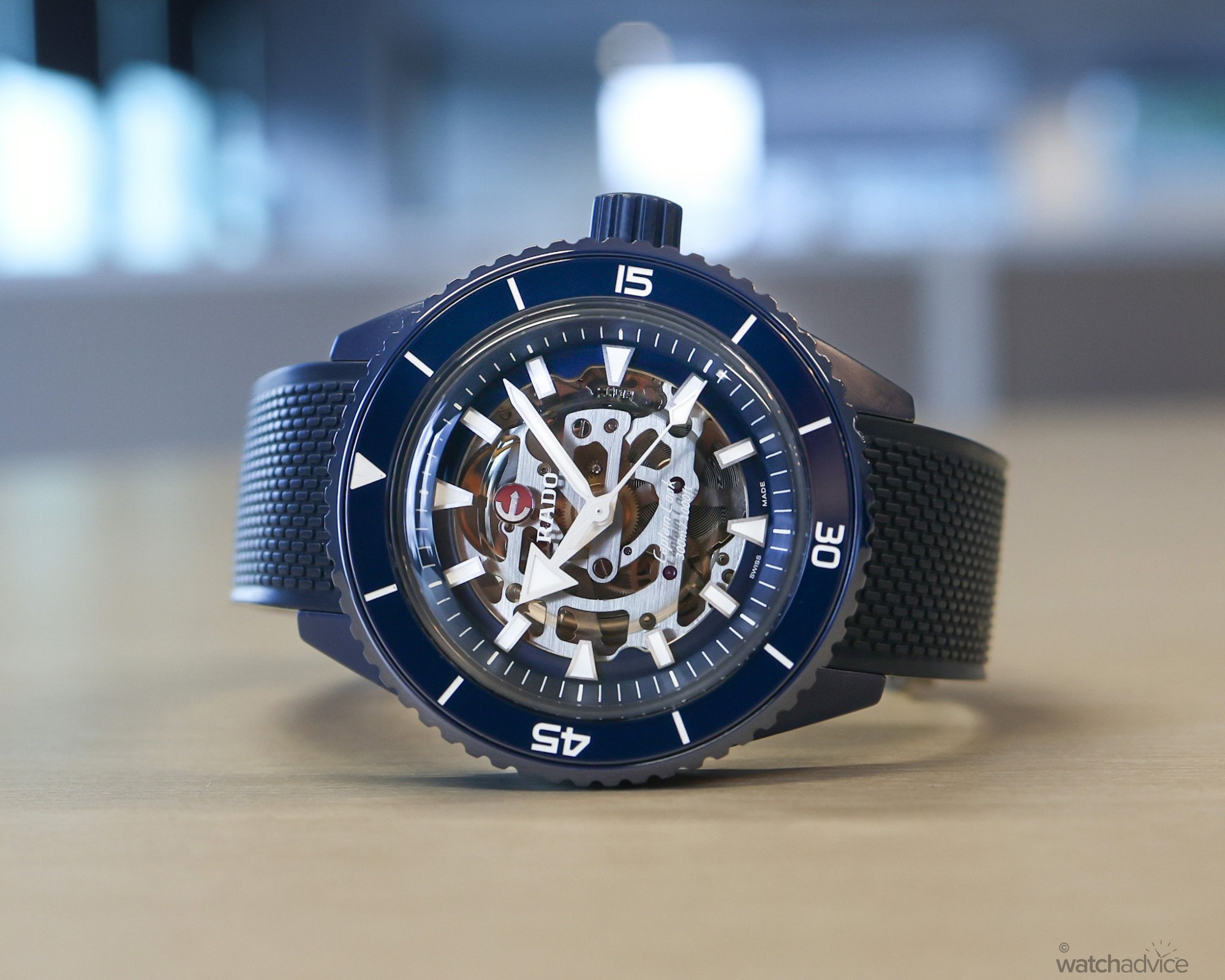
The contrasting white and blue works well with this, gives it that summer vibe, and stands out. In addition, the skeletonised dial shows off the inner workings of the movement and the white contrasting indices and hands make reading the time super easy, and with loads of lume, the same goes for at night.
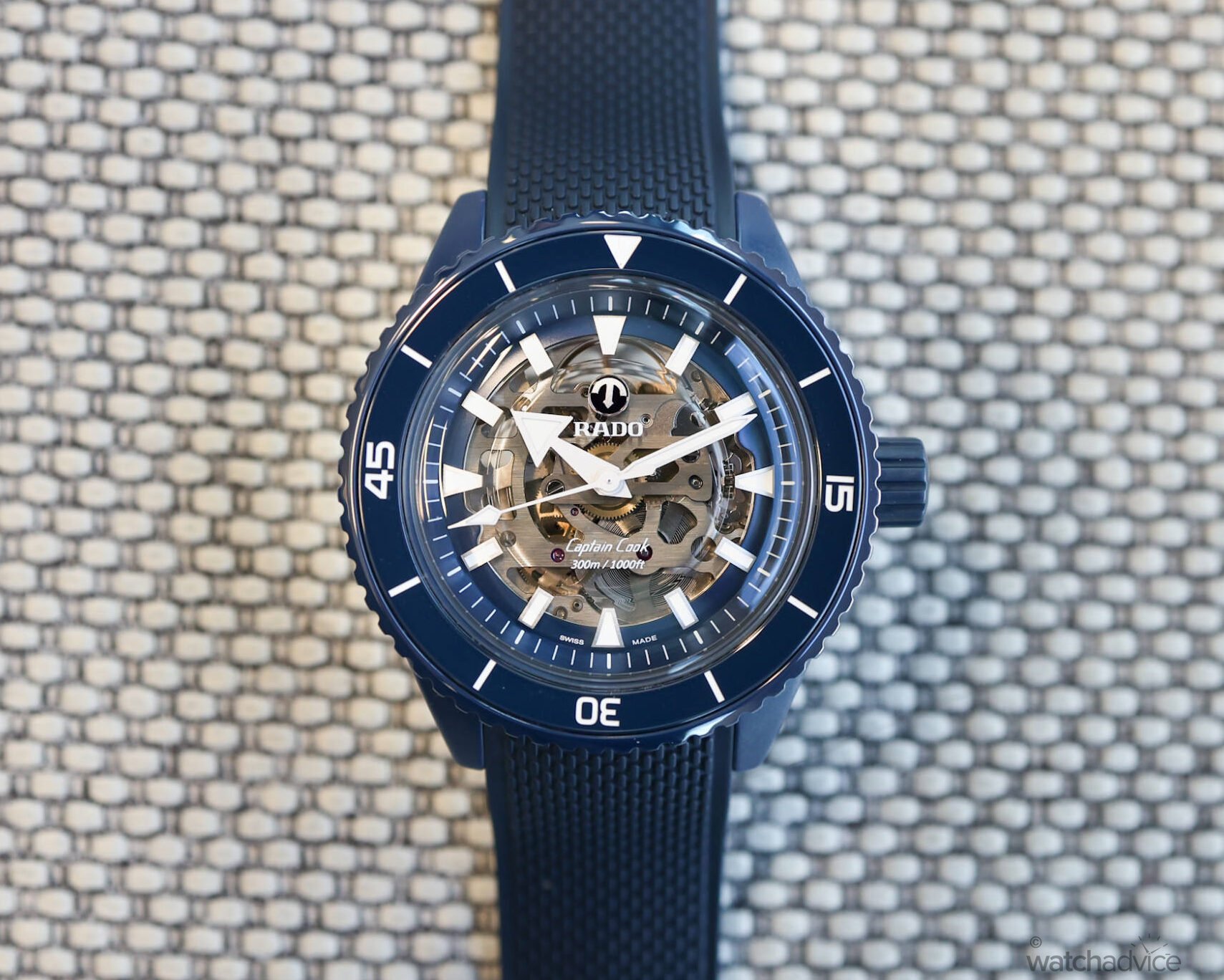
On the wrist, with the rubber strap, it fits well, is comfortable and sits flush to the wrist thanks to the angled lugs. at 43mm in diameter, 49.8mm lug-to-lug and a thickness of 14.6mm, it’s not super small but is designed for robustness and legibility. On Sameera’s wrists below, which are about 16.5cm in size, it sits well and is not overbearing at all!
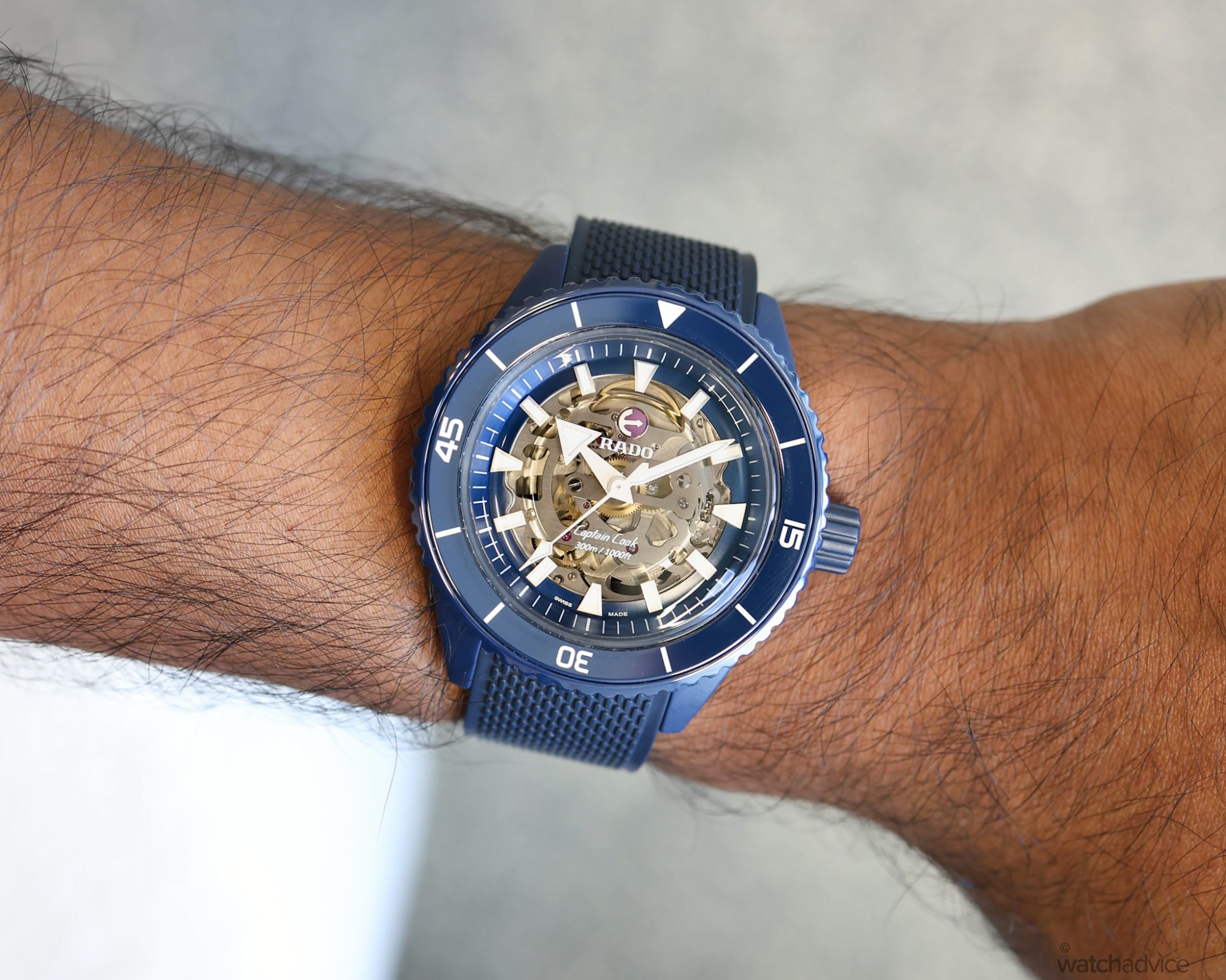
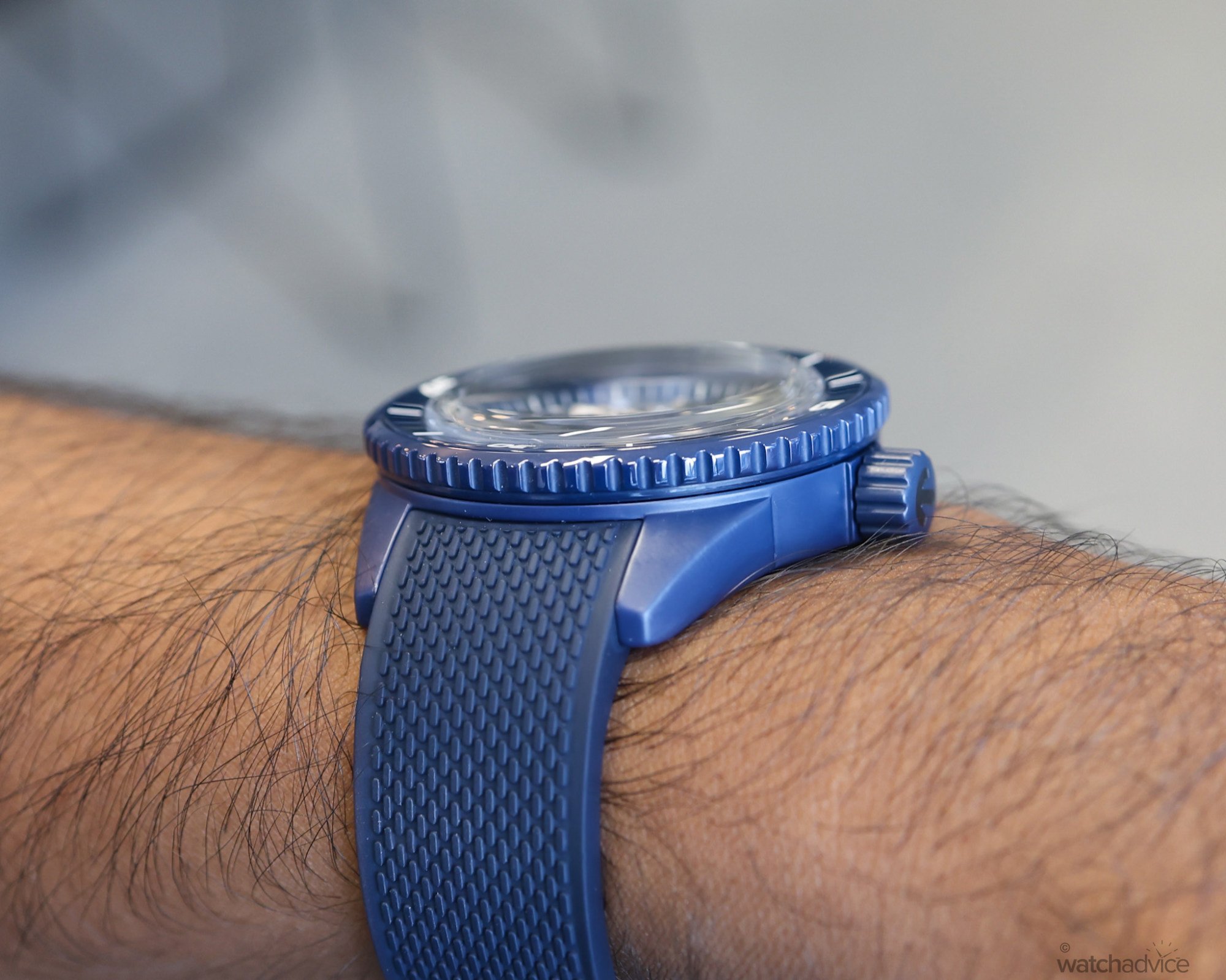
RELATED READING: Introducing Rado’s New Captain Cook High-Tech Ceramic Skeleton In Blue!
In addition to the blue, Rado released their Captain Cook High-Tech Ceramic Skeleton in Olive Green and contrasting Rose Gold in March. If you missed the release of it, you can read all about it here. Done in a full High-Tech Ceramic bracelet (or the option of a matching rubber strap) the piece keeps the Captain Cook DNA but with a twist of gold plus a smoked sapphire glass disc on the skeletonised dial. See for yourself below…
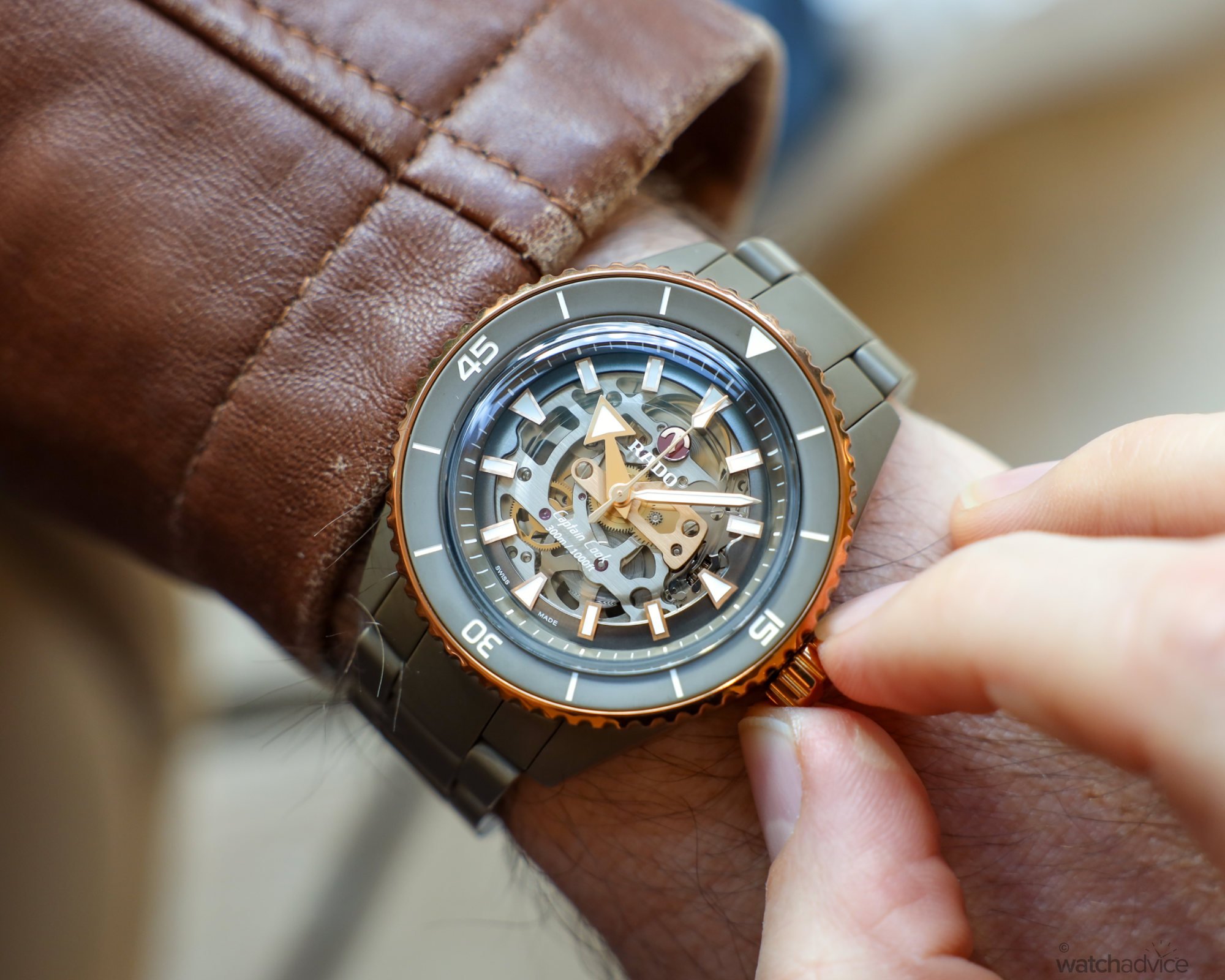
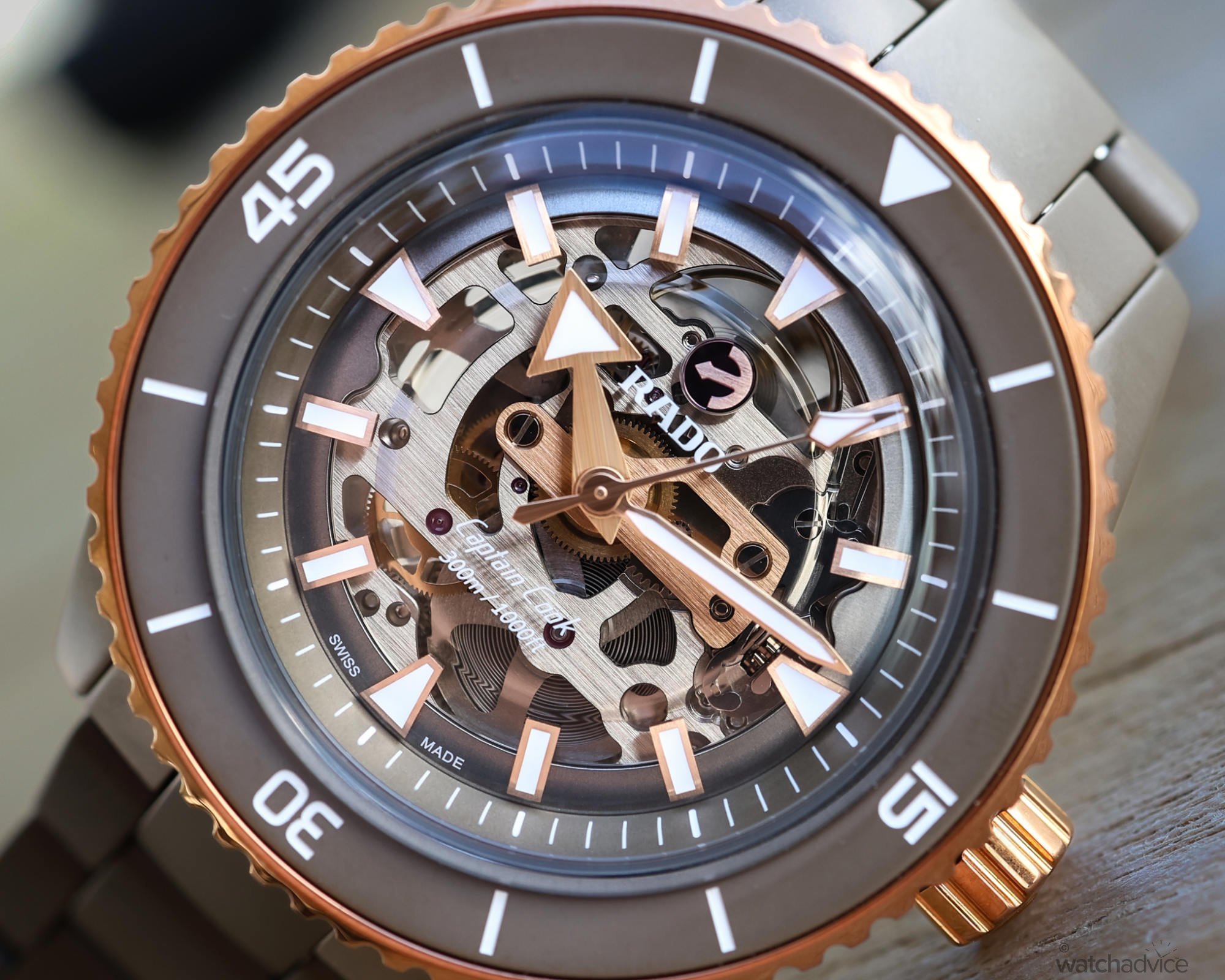
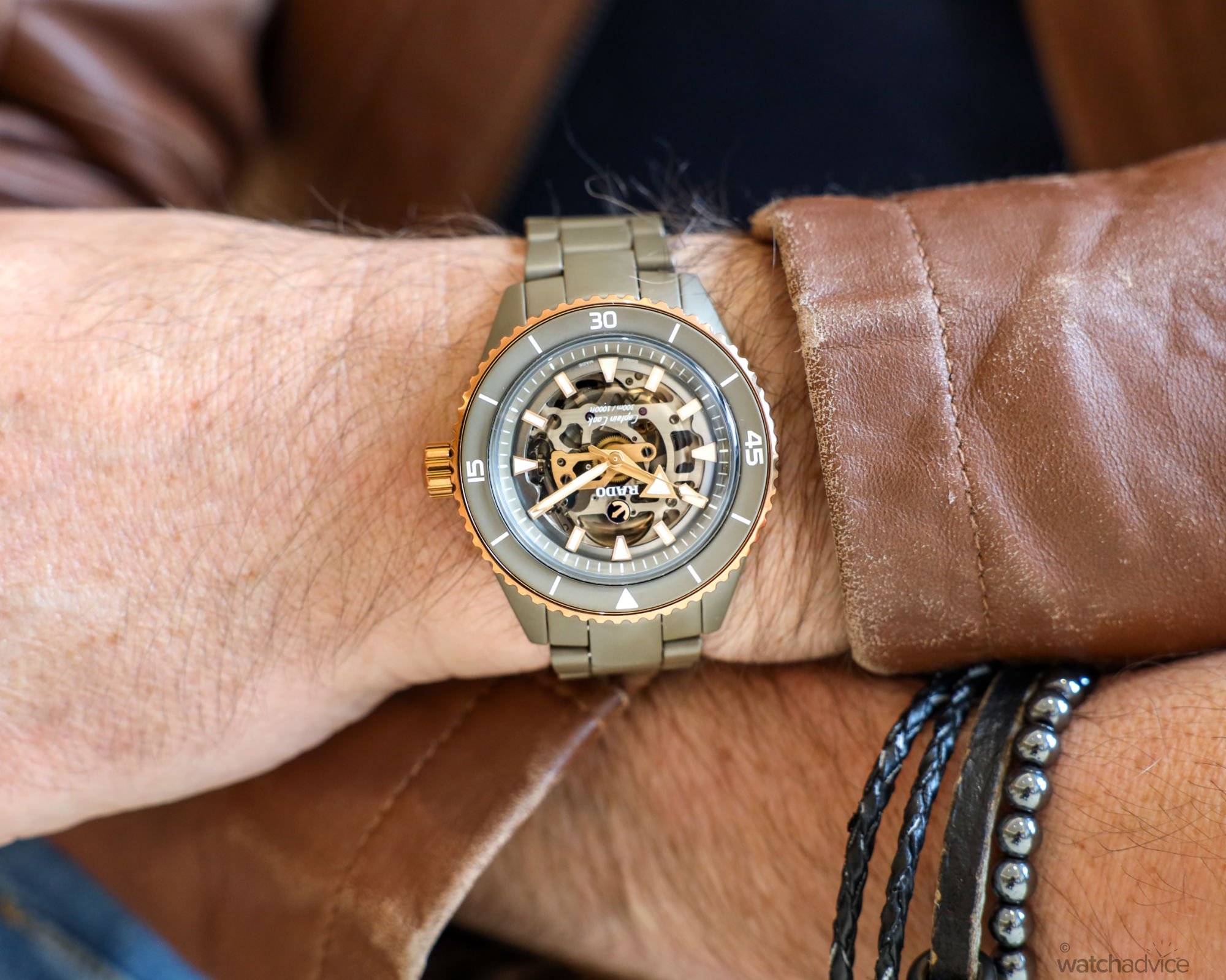
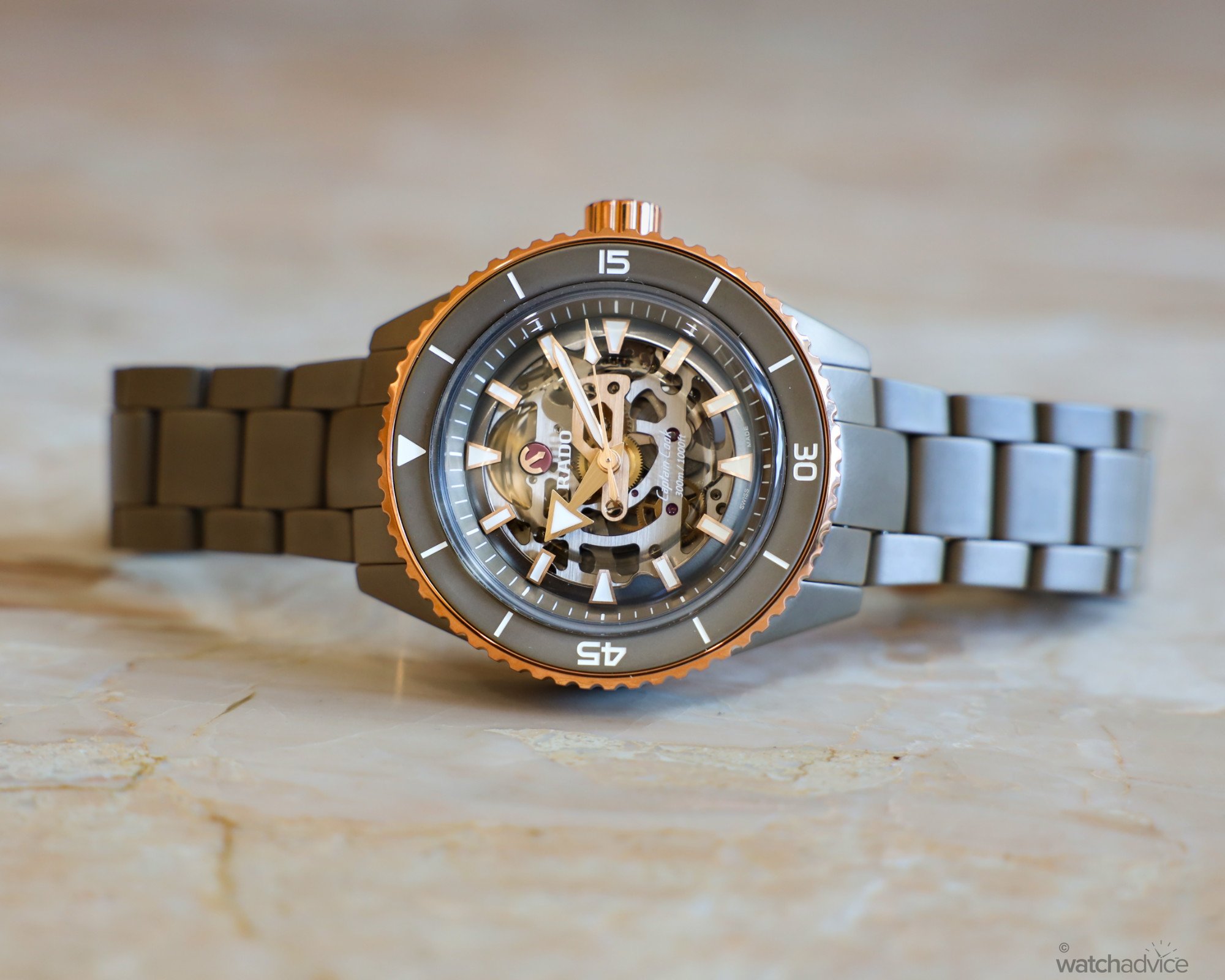
When it comes to Rado and The Captain Cook, it’s not all about High-Tech Ceramic. Rado has played around with other materials as well, and of course, delving into these with their iconic Captain Cook. The one that stands out the most to us is bronze. Bronze is a living alloy, and is made up of copper and tin, and depending on the hue and how patina resistant you want the alloy to be, the makeup is different. In Rado’s case, a hypoallergenic copper aluminium alloy, which gives the bronze a slightly lighter golden look than other brands with bronze watches on the market.
We had the pleasure of reviewing this piece back in November of 2022 just after it was released, and the combination of the blue dial, blue High-Tech Ceramic bezel and the lighter shade of bronze really hit home for us. This is coupled with the blue Nato strap with the golden bronze-coloured stripe down the centre. The bronze buckle and strap minders also tie this whole look together nicely and gives the piece a modern, yet vintage feel.
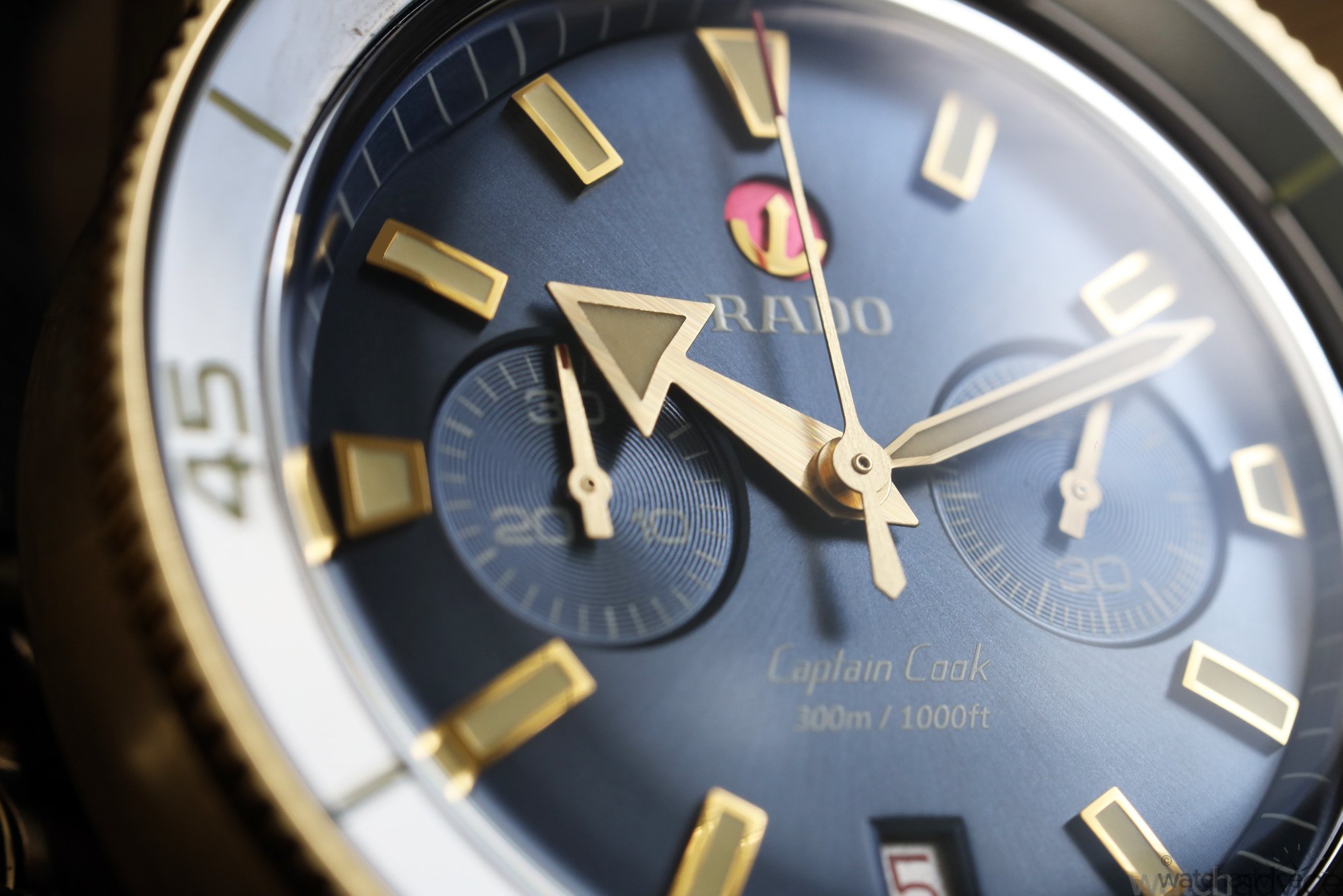
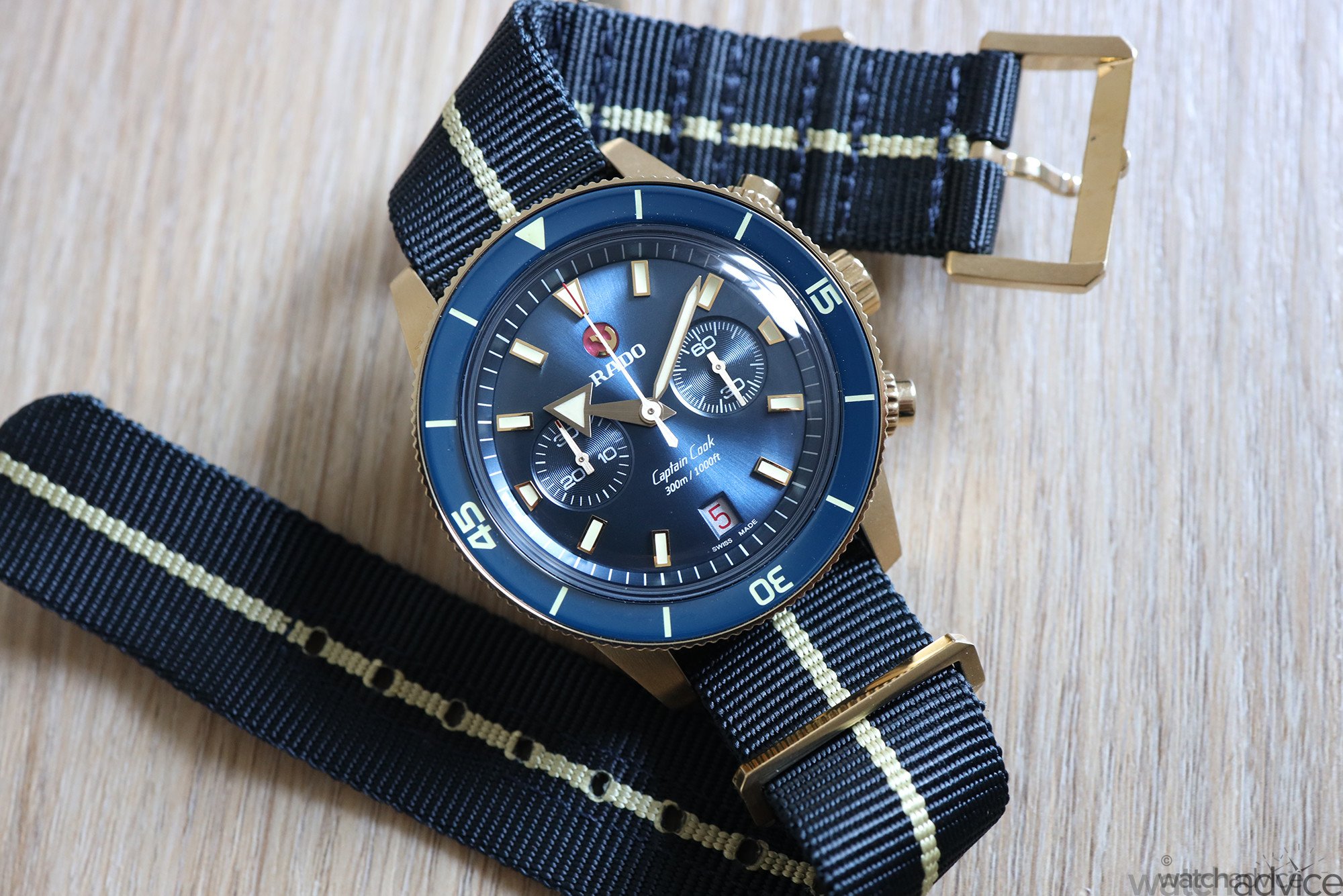
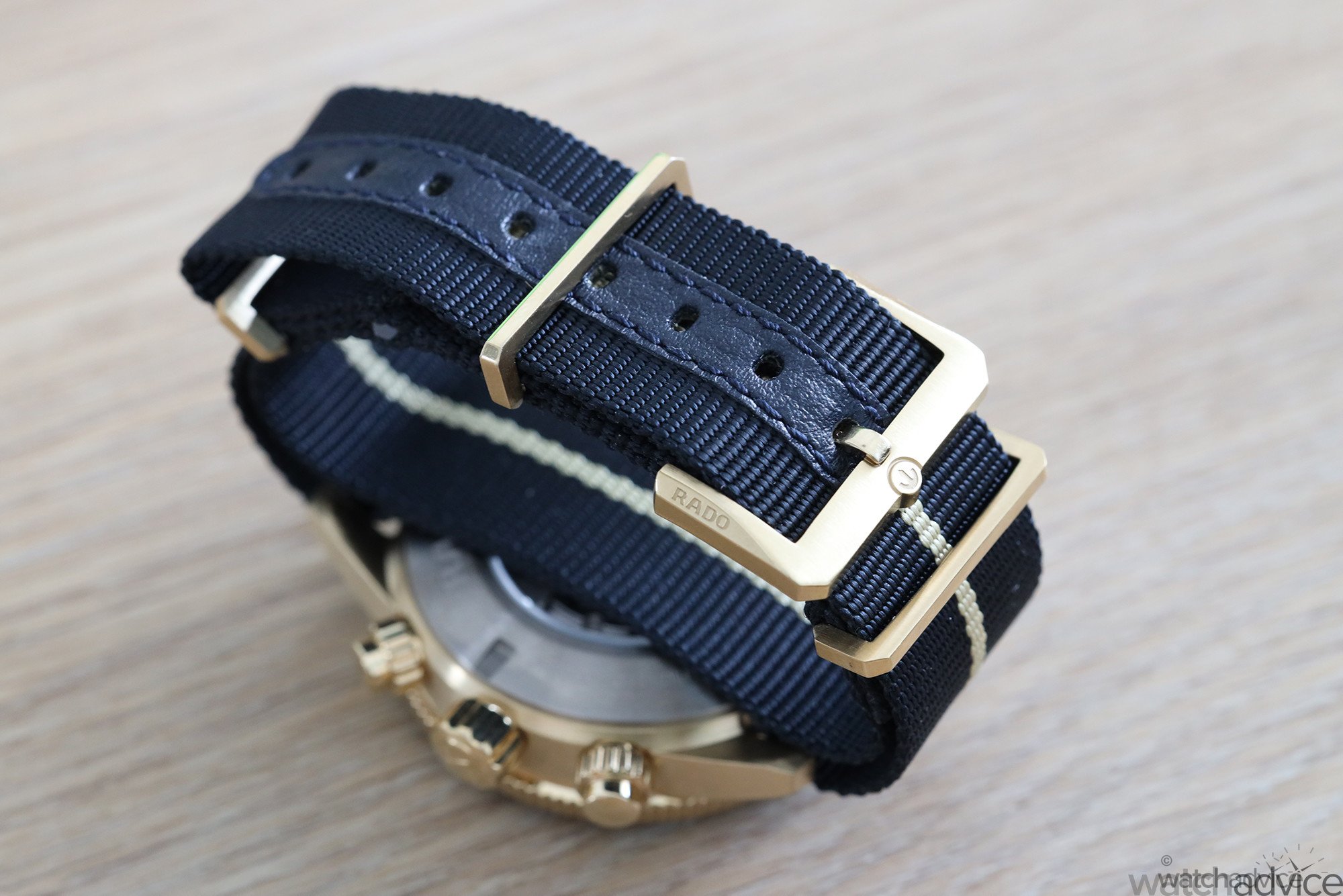
The watch didn’t patina much at all either during our time with it, which on a personal note I liked as the colour combination and specific colour of the bronze works magically. It’s a piece which you almost want to stay clean and not age. it will inevitably as all bronze watches do, but due to the mix of copper and aluminium, it ages slower than other watches from more expensive brands do.
Final Thoughts
This wouldn’t be a Watch Advice article without concluding with some final thoughts – like all our articles. We’ve covered Rado a lot over the years, more so out of good fortune than design. I’ve mentioned many times that Rado does have a bit of a soft spot in my heart as it was one of the very first nice watches I bought my wife (then girlfriend) over a decade ago. She even was kind enough to review the Rado Centrix Automatic Diamonds you may have seen former World No.1 Tennis star and Rado Ambassador Ash Barty sporting on her wrist as a result to see how she feels about it all these years later.
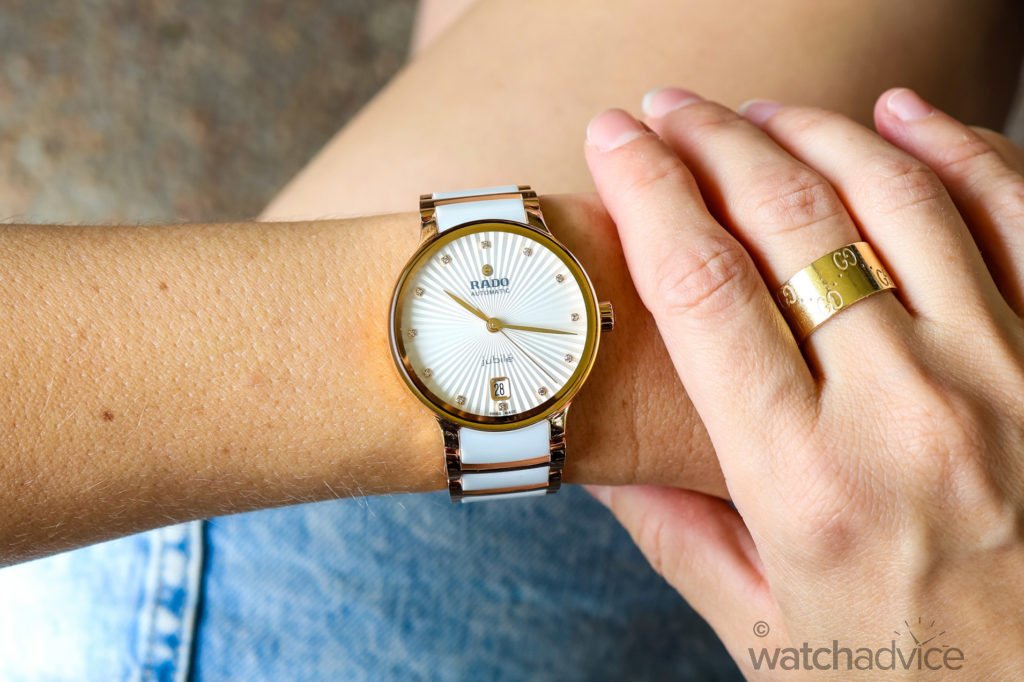
Rado is a brand that should be on more people’s radar, especially here in Australia as they are great watches for our lifestyle. The Captain Cook range has something for everyone, and even though we’ve not touched on it much here, the Women’s range is equally as nice – like the limited edition Captain Cook Marina Hoermanseder Heartbeat pictured below.
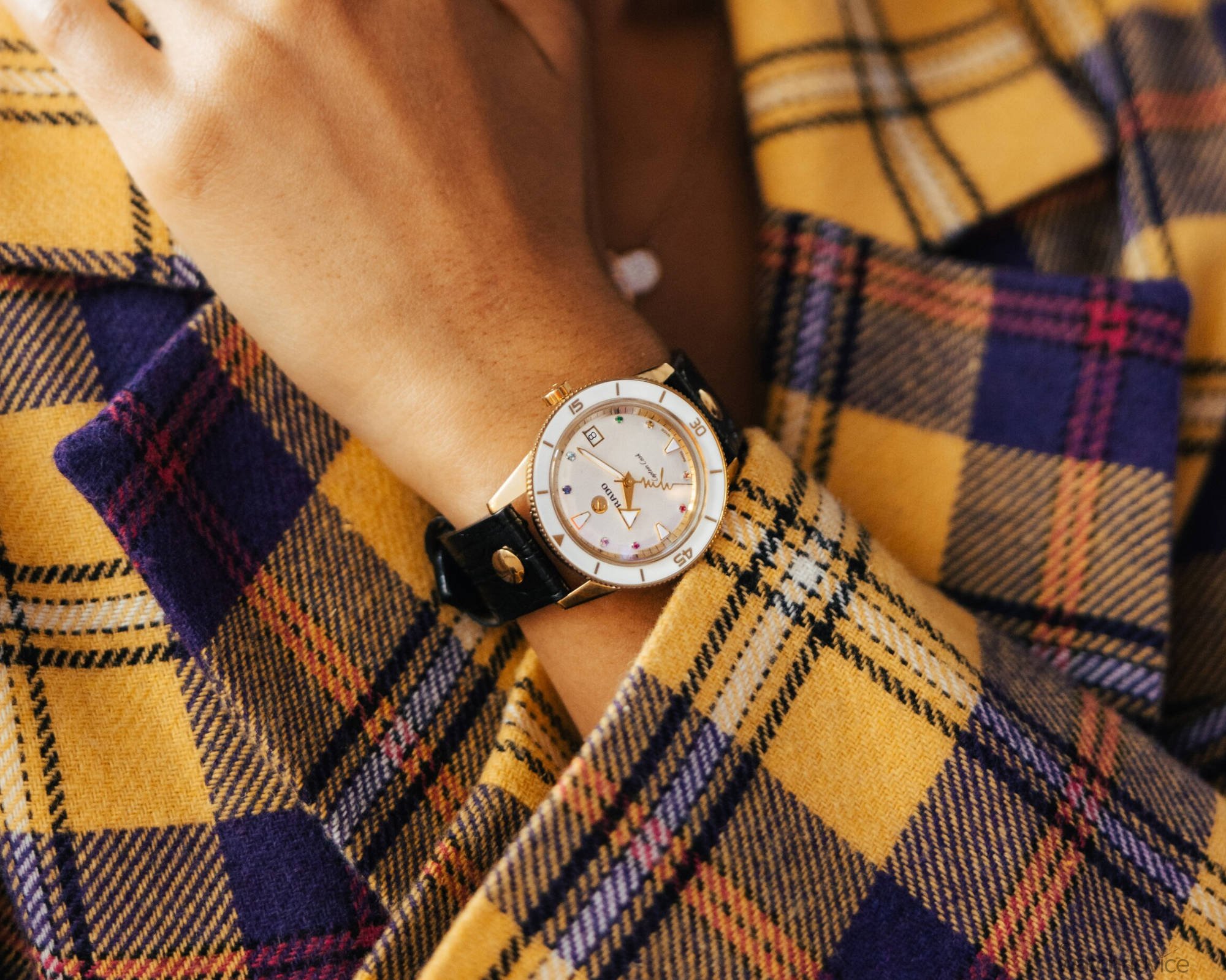
But going back to the core collection, the Captain Cook is a robust everyday watch, and the High-Tech Ceramic Models are built to withstand the outdoors lifestyle and adventures we may go on, be it out and about on the weekend, or getting out into nature and exploring. Check out Watch Advice Founder, Chamath (ChampsG) doing a spot of mountain biking in Tasmania with the Rado Captain Cook strapped to his wrist. If you want a brand to put its money where its mouth is, then the below is a great example of this.


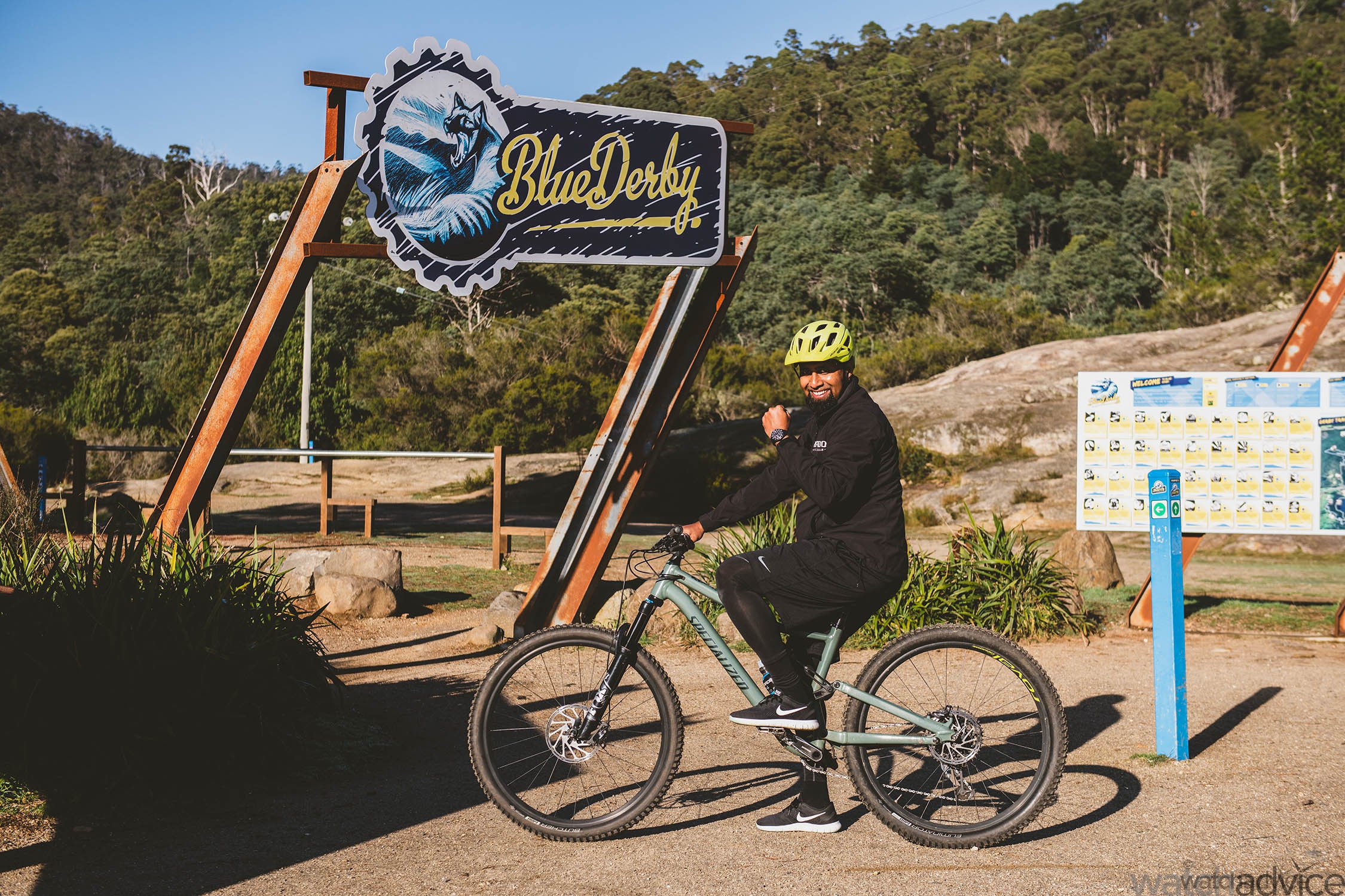
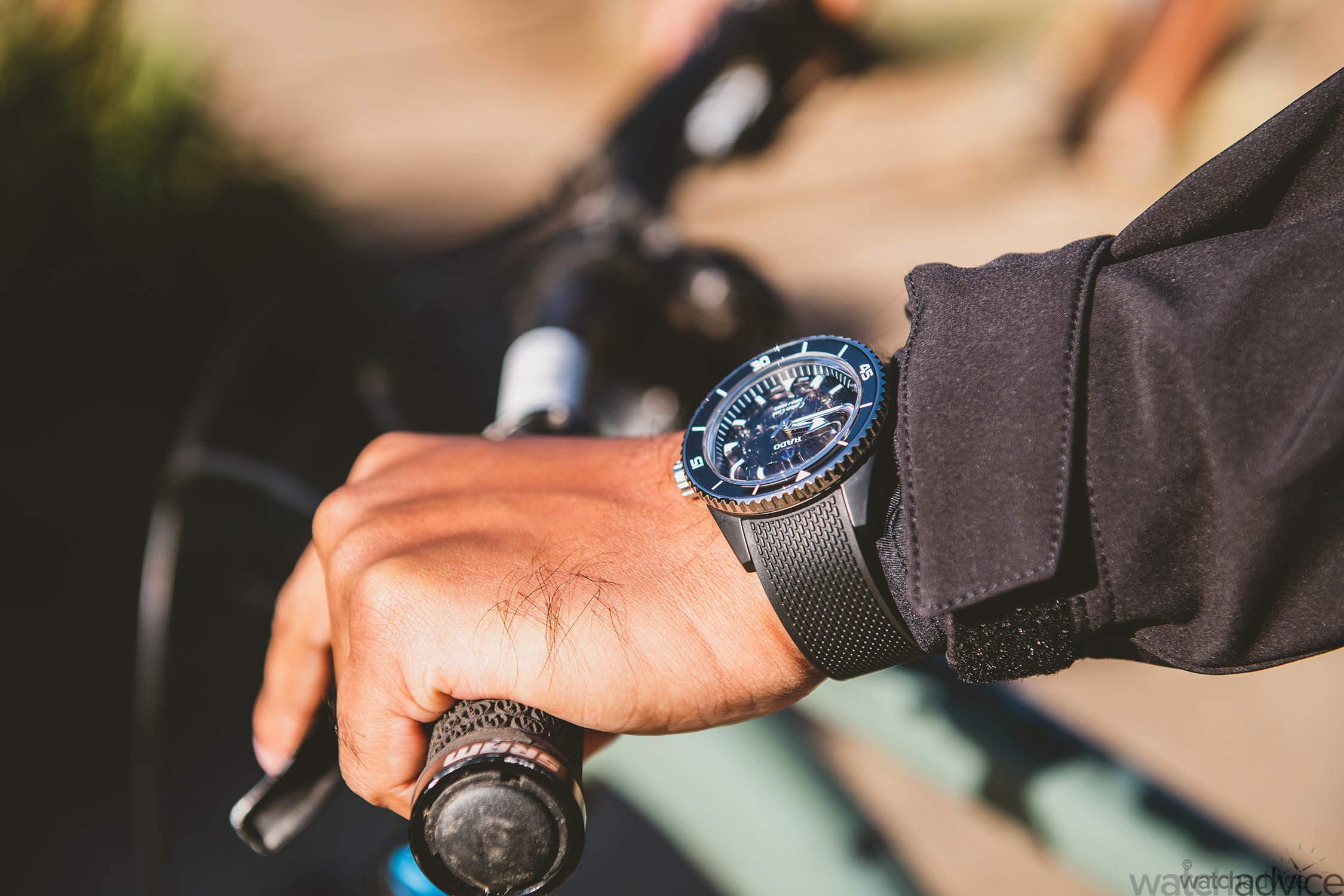
If you’re in the market for a new watch, check out the new Rado Captain Cook High-Tech Ceramic Skeleton in Olive Green at Rado.com
For more articles and reviews on Rado, head over to our Brands section on the site HERE.
This article was written as part of a commercial partnership with Rado. Watch Advice has commercial partners that work with us, however, we will never alter our editorial opinion on these pieces, a fact that is clearly communicated to the brands when entering into a commercial arrangement. At Watch Advice, we categorically do not sell outcomes or our editorial integrity. We will never say a watch is good when it’s not.


